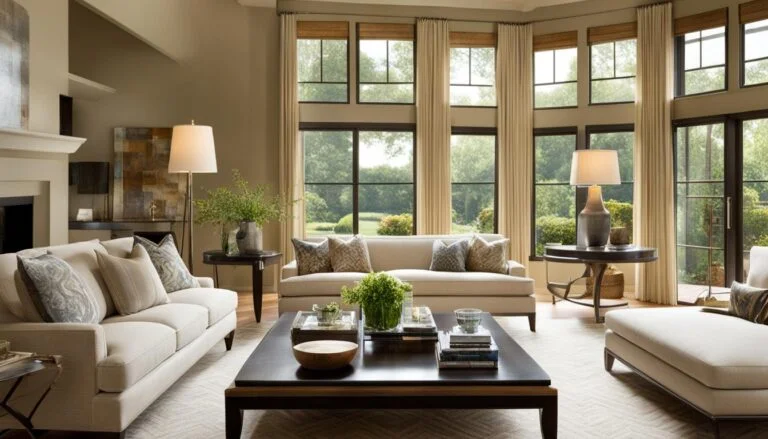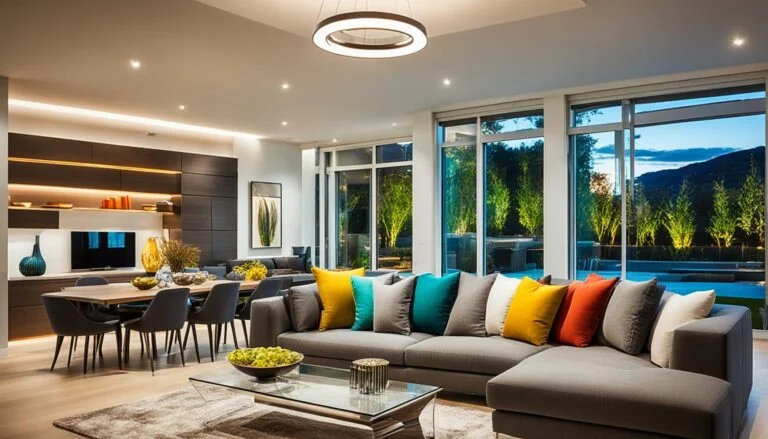Creating a cohesive interior color scheme can transform your home into a harmonious and stylish haven. But where do you begin? Don’t worry, we’ve got you covered with this step-by-step guide. Whether you’re starting from scratch or looking to refresh your current Interior Color Schemes, these tips will help you achieve a polished and cohesive look throughout your home.
Key Takeaways:
- Follow a step-by-step guide to create a cohesive interior color scheme.
- Consider your color preferences and existing décor to determine your color personality.
- Choose a base color that will tie your rooms together and create consistency.
- Select 4-5 accent colors that complement your base color for added interest.
- Incorporate textures through fabrics and materials to enhance the overall aesthetic.
Determine Your Color Personality
When it comes to creating your interior color scheme, understanding your color preferences is essential. Your personal style and the colors you are naturally drawn to can provide valuable insights into the color choices you should implement in your home.
Start by examining your current home décor. Take note of the colors that dominate your space and the ones that you find particularly appealing. Consider the colors you prefer to wear as well, as they often reflect your personal taste and aesthetic.
By paying attention to the themes and patterns in your color choices, you can gain a deeper understanding of your color personality. Do you tend to gravitate towards bold and vibrant hues, or do you lean towards softer, more muted tones? Are there specific color families or combinations that consistently catch your eye?
Your home should be a reflection of your unique style and personality. Understanding your color preferences will help you create a space that feels authentic and resonates with you on a deeper level.
Once you have identified your color personality, you can determine whether you want to stick to similar colors or explore different palettes. This will guide your color choices and ensure that your interior color scheme aligns with your personal preferences and desired ambiance.
Color Personality Examples:
| Color Personality | Characteristics |
|---|---|
| Bold and Vibrant | Enthusiastic, energetic, and confident |
| Soft and Subtle | Calm, peaceful, and harmonious |
| Earth Tones | Grounded, natural, and organic |
| Monochromatic | Sophisticated, timeless, and elegant |
Remember, there are no right or wrong color choices. Your color preferences are unique to you and should reflect your personal style and taste. Embrace your color personality and let it guide you in creating a beautiful and harmonious interior color scheme for your home.
Choose Your Base Color
The base color is the foundation of your interior color scheme. It serves as the backdrop that ties all the rooms together, especially in the main living areas of your home. When selecting a base color, you have the option to go with neutral colors or any color that resonates with your personal style and comfort.
Neutral colors, such as white, beige, gray, or taupe, are popular choices for base colors. They provide a versatile and timeless canvas that complements various design elements. Using neutral colors as your base creates a cohesive and harmonious look throughout your home.
However, if neutral colors don’t align with your preferences, feel free to choose a base color that reflects your personality. Whether it’s a soothing blue, a vibrant red, or a calming green, your base color should make you feel at ease and create a consistent atmosphere throughout your living spaces.
Remember, the key to achieving a consistent color scheme lies in using the same base color on the walls of connecting spaces, especially in open floor plans. This creates a seamless flow and visual cohesion between rooms.
Now, let’s take a look at a table that showcases how different base colors can influence the overall ambiance of your home:
| Base Color | Ambiance |
|---|---|
| A calming and serene atmosphere that provides a blank canvas for other design elements to shine. | |
| A refreshing and tranquil ambiance that creates a sense of relaxation. | |
 | An energetic and vibrant atmosphere that adds excitement and stimulates conversation. |
| A soothing and natural vibe that promotes a sense of harmony and balance. |
Selecting the right base color sets the tone for your interior color scheme and establishes the overall mood of your home. Consider your personal preferences, the desired ambiance, and the connection between your living spaces when making your decision.
Choose Accent Colors
Accent colors play a crucial role in adding interest and depth to your interior color scheme. By strategically selecting 4-5 accent colors that complement your base color, you can create a harmonious and visually appealing color palette for your home. These accent colors will provide the opportunity to infuse personality and create focal points throughout your main living areas.
When choosing accent colors, it is essential to consider their compatibility with your base color and their ability to enhance the overall color scheme. Keep in mind that accent colors should complement, not overpower, your base color. By using accent colors consistently throughout your home, you create a sense of cohesion and balance.
Choosing Accent Colors for Your Color Palette
The key to choosing the right accent colors lies in understanding the mood and ambiance you want to create in each room. Consider whether you want a warm or cool color palette and select accent colors that align with your desired atmosphere. Warm colors like oranges, yellows, and reds evoke energy and create a cozy atmosphere, while cool colors like blues, greens, and purples promote relaxation and tranquility.
Additionally, you can opt for accent colors in the same color family or variations of a single accent color to maintain consistency as you move from room to room. This approach ensures a seamless flow and a cohesive look throughout your home.
Tip: When choosing accent colors, take into account the existing colors in your furniture, artwork, and accessories. These elements can provide inspiration and guide you in selecting accent colors that complement your existing decor.
To further illustrate the importance of choosing accent colors and how they contribute to a cohesive color scheme, consider the following example:
| Base Color | Accent Colors |
|---|---|
|
In this example, the base color sets a neutral foundation, while the accent colors in various shades of blue, mustard yellow, coral, and gold contribute to a visually dynamic color scheme that is both stylish and cohesive.
By carefully selecting accent colors and incorporating them harmoniously into your interior color scheme, you can create a space that reflects your personal style while maintaining a polished and harmonious look throughout your home.
Incorporate Textures
To add depth and interest to your interior color scheme, it’s important to incorporate different textures into your design. By using a variety of fabrics and materials, you can create visual interest and enhance the overall aesthetic of your space.
One way to incorporate textures is through the use of fabrics. Consider using textured curtains or drapes to add a touch of elegance and sophistication to your windows. Plush area rugs or carpets can also provide a soft and cozy feel underfoot while adding depth to your floors.
Another way to introduce textures is by incorporating different materials. Natural wood, for example, brings warmth and texture to any room. Consider adding wooden furniture, such as a coffee table or sideboard, to create a rustic or organic look. Stone accents, such as a fireplace surround or a stone feature wall, can add a luxurious and earthy touch to your interior.
When incorporating textures, it’s important to consider the overall color scheme and style of your space. Choose textures that complement your chosen colors and create a cohesive look.
Remember, textures can be introduced through various elements in your interior design, such as furniture, flooring, accessories, and even wall treatments. Experiment with different textures to find the right balance and create a space that is visually appealing and inviting.
| Texture | Description |
|---|---|
| Velvet | A luxurious and soft fabric with a plush texture, perfect for upholstery or accent pillows. |
| Leather | A durable and versatile material that adds a sophisticated and timeless appeal to any space. |
| Wicker | Natural woven material that brings a touch of bohemian or coastal style to your interior. |
| Brick | A textured wall treatment that adds an industrial or rustic charm to your space. |
| Metal | Sleek and reflective material that adds a modern and contemporary touch to your interior. |
Conclusion
Creating a cohesive interior color scheme is the key to achieving a polished and harmonious look throughout your home. Through careful planning and consideration, you can create a cohesive whole home color palette that reflects your personal style and taste.
Start by choosing a base color that will tie your rooms together and create consistency. Neutral colors like white, beige, gray, or taupe are popular choices for base colors, but feel free to explore other options that resonate with you.
Once you have your base color, select accent colors that complement it. Choose 4-5 accent colors that can be consistently used throughout your main living areas. You can stick to colors in the same color family or experiment with variations of one accent color as you move from room to room.
Don’t forget to incorporate textures to add depth and visual interest. Experiment with different fabrics, such as textured curtains or plush area rugs, and utilize materials like natural wood or stone to enhance your color scheme. Remember, cohesion is key.
Frequently Asked Questions
How do I determine my color preferences?
Take a look at your current home decor and the colors you prefer to wear. These will give you insight into your color preferences and help you determine what colors you should implement in your home.
What is a base color and how do I choose one?
A base color is the paint color that ties your rooms together and serves as the backdrop in the main living areas of your home. Choose a consistent color, such as a neutral color like white, beige, gray, or taupe, or any color that you feel comfortable with.
How many accent colors should I choose and how do I use them?
Choose 4-5 accent colors that complement your base color and use them consistently throughout your main living areas. Opt for colors in the same color family or variations of one accent color as you move from room to room.
How can I incorporate textures into my Interior Color Schemes?
You can incorporate textures through the use of fabrics, such as textured curtains or plush area rugs, and different materials, such as natural wood or stone. These textures will add depth and visual interest to your space.
How do I create a cohesive whole home color palette?
By choosing a base color, selecting accent colors, using them consistently, and incorporating textures, you can create a polished and harmonious look throughout your home.












